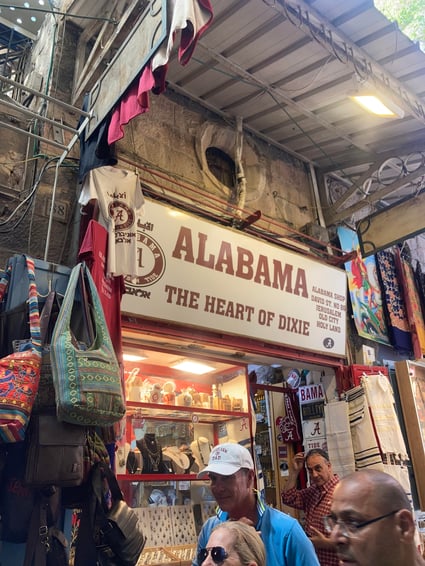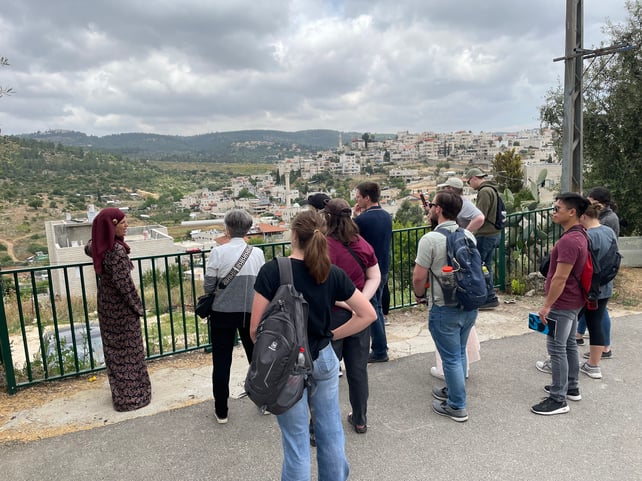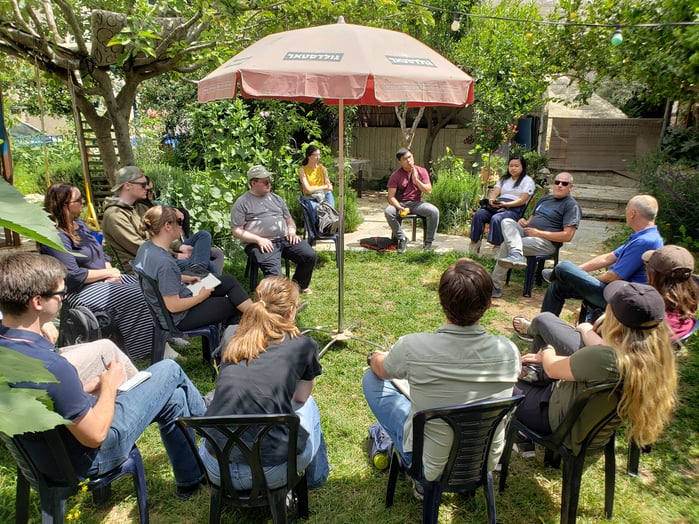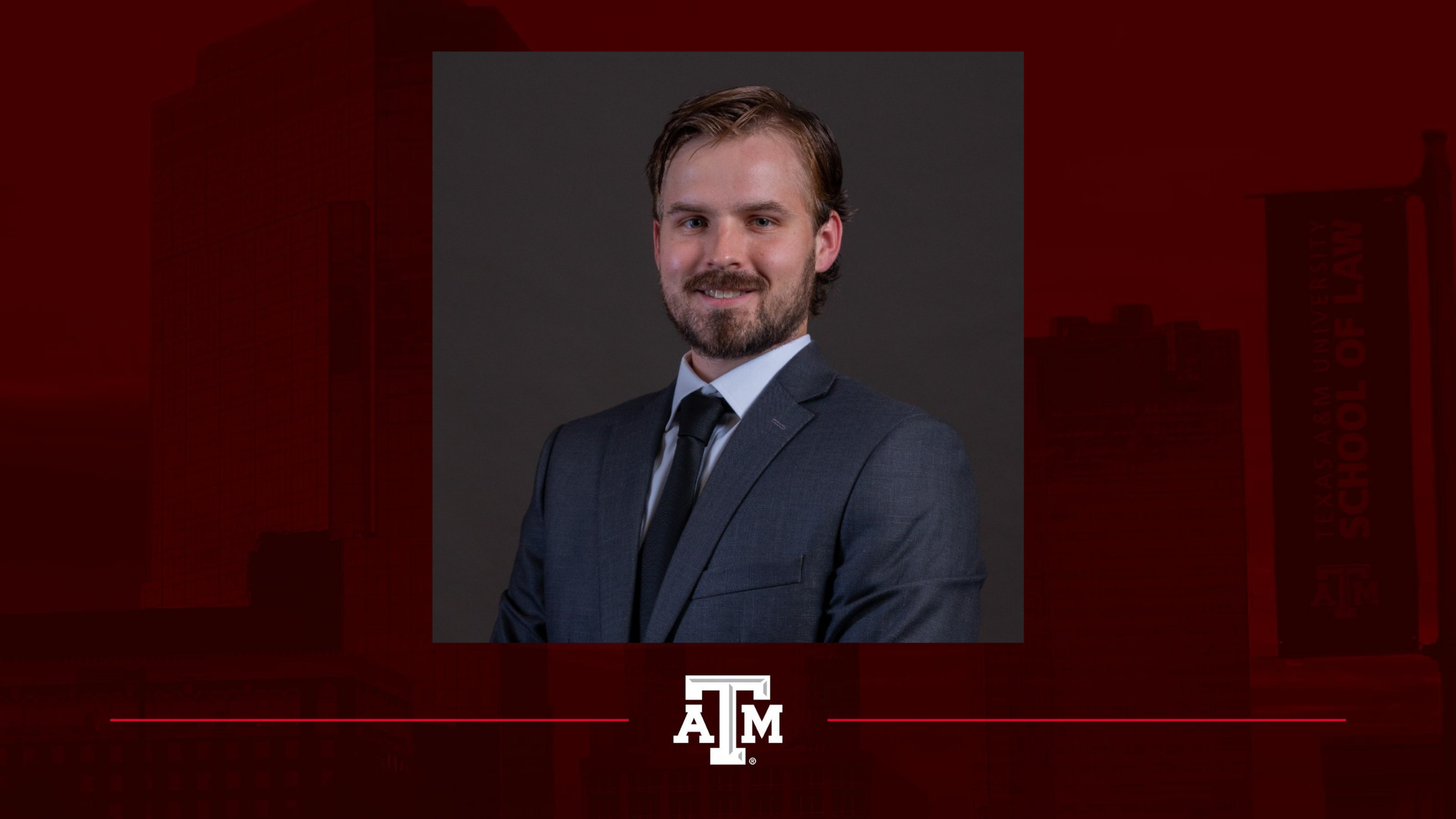Day Thirteen – Our Last Day in Israel
By: Brandon Robinson '25
This article is part of a series of reflections prepared by students enrolled in the Texas A&M School of Law 2023 Global Field Studies Program: Israel. Click here to visit the entire series.
To start off our last day in Israel, we went to the Shuk in the Old City of Jerusalem to try our hands at bartering for souvenirs. Some fared better than others, but everyone walked away with something unique, from travel chess sets to Hebrew t-shirts that would certainly break patent law in the US.
 There were many unique and interesting shops in the Shuk, including the shop pictured, which seemed out of place in the Old City.
There were many unique and interesting shops in the Shuk, including the shop pictured, which seemed out of place in the Old City.
From the Shuk, we traveled to Ein Rafa, an Arab village west of Jerusalem, to speak with Yasmin. Yasmin and her husband Musa live in Ein Rafa and run an open house for discussions with interested groups (usually from Birthright Israel, a group that provides heritage tours for young American Jews) about the life of Arabs living in Israel. Yasmin hopes that the conversations at her house will help encourage tolerance and equality between Jews and Arabs.
While Ein Rafa has a more reliable connection to the grid than most Arab villages in Israel, their cultural differences with the State continue to cause problems in the village, particularly when it comes to urban planning.
In 2007, Yasmin and Musa were awoken at 5 am and given five minutes to gather their things before the State demolished their house. Their house had been constructed in an area zoned for commercial use only, but Yasmin and Musa had submitted a request for the house to be deemed a legal building. This application was in the process of being approved by a state agency. Before the approval was received, the Interior Ministry decided to act on a demolition order that had been issued in 2005. Instead of receiving a month-long notice of the impending demolition—which Yasmin stated that a Jewish family would have received—Yasmin and Musa were given five minutes' notice before the entire house was torn down. A month later, Yasmin received a notice that the first state agency approved her request.
Motivated by this incident, Yasmin went to work on urban development planning to prevent future demolitions of Arab houses and to integrate Arab property traditions into Israel’s planning for communities such as Ein Rafa. The ways in which Arab land has been passed down and demarcated is not considered by Israeli planners. Historically, boundaries were recognized from oral tradition, which has only recently been written down. These oral boundaries are usually not recognized by the Israeli government. Seeking to incorporate these traditions in the area’s planning, Yasmin now works on the development plan for Ein Rafa and has recently claimed a victory. Yasmin and her colleagues successfully appealed the State’s plan for a tract of land on a nearby hill that is currently used for some crop production by Ein Rafa’s inhabitants. The plan would have ignored the historical uses and ownership of the land and the needs of the Arab inhabitants of Ein Rafa. Yasmin and her colleagues must now come up with a development plan for that area that will satisfy the State while protecting the Arab citizens’ goal of conservation of the land.
After our talk, Yasmin led us on a walk to an overlook to see Ein Rafa (below the overlook) and Abu Ghosh (right side of the photo). The area on the left side of the photo is the area for which Yasmin and her colleagues must now propose a development plan. On the far side of the valley on the opposite hills we caught a glimpse of Professor Eckstein’s hometown of Beit Nekofa.

After lunch, we gathered in Yasmin’s and Musa’s garden for one last talk with Dr. Clive Lipchin where we reflected on our two weeks in Israel. Clive was especially interested to hear about our favorite parts of the trip. People obviously talked about swimming in the Dead Sea or hiking in Makhtesh Ramon, but everyone was most struck by how much we had learned in just two weeks about the Bedouin’s situation specifically, and the state of Jewish/Arab relationships at large in Israel, as well as the complexities surrounding proposed solutions. Afterwards, we discussed Clive’s goals and desires for Laguna and his system, and how our research might support his objectives.

Back in Jerusalem that night, we all went out for one last dinner as a group to celebrate and further reflect on all that we had learned and the unique opportunities we had experienced over the past two weeks.
Learn more about Texas A&M University School of Law's Global Law and Policy Program, Aggie Dispute Resolution Program, and Energy, Environmental, and Natural Resource Systems Law Program
